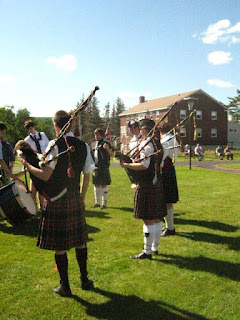I would like to say thank you to the Council’s previous blog
writer Brendan Ahern for interviewing me in his last post, as well as the kind introduction.
I am happy to be contributing to this blog for the remainder of my time working
for Comhairle na Gàidhlig.
While continuing on the topic of people who are contributing
to the revitalization of Gaelic language and culture in Nova Scotia, I decided
to meet with Crìsdean and Ròs
Cuimean last week to interview them about their involvement with Gaelic language
and culture in the community, as well as in their home.
During the interview Crìsdean and Ròs shared with me how
they first started learning Gaelic, “we were planning our wedding and we wanted
to incorporate Gaelic culture into our ceremony to respect our heritage.” After
researching Gaelic culture and different ways they could incorporate it into
their wedding, they decided to start Gaelic classes at Sgoil Ghàidhlig an
Àrd-bhaile (which is coincidentally where I first started my own Gaelic
learning journey, and met Crìsdean and
Ròs myself!).
The couple both have connections to Gaelic; Ròs herself was
born in Glasgow, Scotland (she has lived in Canada since she was nine years
old) and recalls being exposed to Gaelic from a young age. “We had Gaelic
programming on our TV but there was often no interest from those around us, and
it was usually viewed in a negative way. Gaelic was not passed through the
family either.” She continued to say that even though there was little interest
in Gaelic, the language was literally all around them and that “there were
words in Scotland that we used all the time, but didn’t realize they were
actually Gaelic". Crìsdean also
shared that his roots were Gaelic (as well as Welsh and Irish), and that he
also felt a strong interest in exploring his roots.
After taking classes at Sgoil Ghàidhlig an Àrd-bhaile, Crìsdean and Ròs began to
incorporate Gaelic culture into their everyday life. The couple explained to me
that they began speaking the Gaelic they had learned to their sons Keegan (17
years), Aonghas (2 years), and now hope to continue speaking and teaching
Gaelic to their newest family addition, Lachlann (1 month old).
“Gaelic is very much an everyday part of life for our
family” says Crìsdean. “In fact, it is the first language (including English)
for Aonghas, who picks up Gaelic very quickly from us and has full
comprehension.” Crìsdean further explained that “Aonghas has been exposed to Gaelic from birth and we use as
much Gaelic as we can everyday with our whole family.”
The couple also takes part in step dancing and singing which they
both teach to their children and include in their daily activities; Crìsdean
has even been learning the fiddle. The children are also exposed to Gaelic
through their favorite television shows. Ròs shared that “Aonghas watches
Gaelic cartoons everyday on BBC Alba such as Peppa Pig, Rupert, Padraig Post
and many more.”
In addition to music, dance, and singing in the home, Ròs does
traditional weaving and spinning using fleece from local farms as well as local
and Scottish plants for dye, all using a traditional spinning wheel and looms (one
of which is estimated to be about 200 years old). She explained that “plants
from different areas even an hour away will give a different color”, and also that
“in Scotland different colored dyes from plants are associated with different
areas geographically.” All of these things make traditional weaving unique to the
area it is crafted in.
Outside of their home Crìsdean and Ròs enjoy attending as
many Gaelic events as they can within the community, such as millings, ceilidhs,
and much more. They strongly believe that supporting and sharing Gaelic culture
through the community is just as important as in the home. Ròs explained that while
growing up in Scotland even your neighbors were called “Auntie”, and that the
concept of family is so closely tied to community. The couple further explained
that “sharing language and culture is what makes us Gaels” and that “the
concept of family is more than just a last name, it is also a community, it is
people sharing a language and culture.”
It is wonderful to see a family working together to help
keep these Gaelic traditions alive through language, music, as well as arts and
crafts in the home and community. Crìsdean and
Ròs hope to continue attending community events, they also hope to continue
their Gaelic language studies and plan to be entirely fluent in Gaelic. Through
writing, speaking, and listening they hope to bring Gaelic into their home and
pass it onto their children, so that they too can help contribute to the future
of Gaelic in Nova Scotia.
Gach deagh dhùrachd / Every good wish!
















